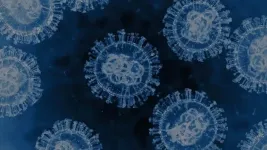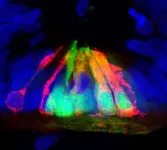(Press-News.org) UNIVERSITY PARK, Pa. — Microorganisms — bacteria, viruses and other tiny life forms — may drive biological variation in visible life as much, if not more, than genetic mutations, creating new lineages and even new species of animals and plants, according to Seth Bordenstein, director of Penn State’s One Health Microbiome Center, professor of biology and entomology, and the Dorothy Foehr Huck and J. Lloyd Huck Endowed Chair in Microbiome Sciences. Bordenstein and 21 other scientists from around the world published a paper in the leading journal Science, summarizing research that they said drives a deeper understanding of biological variation by uniting life’s seen and unseen realms.
The authors explained that this newly described concept — holobiont biology — underpins a multidisciplinary and holistic understanding of how life’s forms and functions, from human disease to agricultural output, depend upon the relationships between microorganisms and their hosts. Penn State News spoke with Bordenstein about the paper and the emerging field of holobiont biology.
Q: In simple terms, what is evolution? Why do organisms vary in traits?
Bordenstein: The longstanding definition of evolution is the process by which living things change over time by gradually mutating and adapting to their environments. This happens often through a process known as natural selection, where traits that help an organism survive and reproduce are passed on to future generations, while less useful traits gradually disappear.
Historically, we’ve looked at the timescale for evolution as happening over many generations, with these small changes eventually leading to the development of new traits and even new species. Now, when it comes to incorporating the microbiome, the collection of all microbes in and on a host, into this discussion, the timescale and magnitude of biological change becomes more interesting and complex.
Q: What can this new paper tell us about what has been overlooked in the study of life?
Bordenstein: Traditionally, biologists have studied visible and invisible life in silos, which has caused our concepts of life to separate. Many scientists were settled in their ways of thinking of microbes as background noise, or transient contaminants without major impact on host life. Yet microbial cells in and on the human body can actually outnumber human cells.
What we’re learning today and over the past decade, is that that sometimes microbes explain more biological trait variation in organisms than the genes do. This is the case, for instance, with the likelihood of human colon cancer, cholesterol levels, and body mass index. And, more importantly, if you take host genetics and microbes together, you start to see a fuller picture of how life varies and changes over time.
Microbes are the base of the biosphere. They outnumber the stars in the universe by orders of magnitude and have been here for four billion years. There are more bacteria in your mouth than there are people on the planet. Every host organism lives in contact and association with microbes, and those microbes can cause variation in traits, whether it's chronic disease, agricultural output, biodiversity loss or how thin we are — there's a lot going on that microbes contribute to.
Q: Historically, the field of biology tends to categorize living things into taxa, the filing system for species, genus, family, order, etc. How does holobiont biology fit into or challenge that framework?
Bordenstein: We envision that microbes are fundamental to how biologists explain variation in host life forms, for example animals and plants. So, in the case of classification of species, we’re making the case that organisms are not autonomous. They exist, by definition, always in association and in contact with microbes.
Just has been done with genetic engineering and selective breeding, we see this holistic way of thinking about life as an opportunity to harness the power of the microbiome to make improvements in agriculture and aquaculture, resilience in environmental sustainability, and advances in human health.
This holistic approach of holobiont biology will open the door to finding applications for live microbial communities that could, for example, make agriculture more resilient to climate change, help sustain biodiversity or improve human health by using microbes to combat chronic diseases including cancer, inflammatory bowel disease, cardiovascular disease, and diseases associated with aging.
Q: Essentially, you are saying that we should have a much broader view of what biology looks like, what evolution looks like, because there is an entire world on the microscopic level that is propelling life on the macro level. You reference “Origin of Species,” Charles Darwin’s seminal work published in 1859, frequently in your paper. Why re-examine a 165-year-old book when introducing a new paradigm?
Bordenstein: Darwin's “Origin of Species” remains the bedrock of modern biology today. But it’s worth noting that the Origin of Species was written only about animals and plants. There were no bacteria in it. That doesn't mean that Darwin’s principles do not apply to microbes, but he was focused on what he could see at the time. Now, we have a much fuller picture of the biosphere. What Darwin did was explain to us why forces of evolution shape lineages into new varieties and ultimately into new species, but he didn't know the mechanisms that made these changes possible. He didn't know about genetic mutations nor the microbial forces at work.
Q: You also address Mendelian genetics in the paper, the science of breeding for various traits as described by Gregor Mendel in the 1860s. There have been significant advancements in the study of genetics over the past century, from sequencing to editing, so how does the holobiont biology framework intersect with our modern understanding of genetic diversity and evolution?
Bordenstein: During the 1920s to 1940s, biology had a revolution known as the Modern Synthesis, in which the 19th century discoveries of Mendel's genetic laws merged with Darwin's theory of evolution to create this beautiful explanation for how new variations of form and function develop. That science is what drove biology to where we are today.
Now, many scholars think we're in a post-Modern Synthesis because we're now adding microbiology into our understanding of host genetics and evolution. We’ve learned that microbes are also sources of new forms, functions, and variants of host life, just like genetic mutations. As a consequence, several operational and practical steps can be taken to infuse holobiont biology into the full fabric of the life sciences.
Q: How do you bring about this new paradigm shift in the life sciences?
Bordenstein: It starts with how we define and teach biology. That means rethinking how we describe animals and plants; we're not calling them animals and plants anymore. We’re thinking of animals and plants as a consortium of host and microbial cells that influence anatomy and physiology, because that is the reality of nature. We cannot think about animal or plant genomes in a way that's separate from microbial genomes when we know that both genomic compartments are all part of the functional unit.
There is also a statistical, analytical aspect to what we're going to see next. Just as we have databases to determine the influence of genetics on traits, we will need new analytics to determine the contribution of microbes and how they interact with genetics to explain traits.
Finally, once we have the databases and analytic tools developed, we can engineer microbes and microbiomes as much as we can engineer genes to make a better outcome for an organism, whether that’s in agriculture, the environment, or even for ourselves. Our hope is to use this concept to engineer a better future.
Other Penn State co-authors are Mónica Medina, professor of biology, and Nichole Ginnan, research project manager. Other authors on the paper are affiliated with the Center for Evolutionary Hologenomics at the University of Copenhagen, the Department of Natural History in Trondheim, Norway, the Università degli Studi Mediterranea di Reggio Calabria in Italy, the University of Padua in Italy, Aalborg University in Denmark, the Khalifa Center for Genetic Engineering and Biotechnology at the United Arab Emirates University, the Universidad Nacional de Colombia, Wayne State University School of Medicine, Clemson University, the University of Connecticut, Oregon State University and the University of Pittsburgh.
END
How do microbiomes influence the study of life?
2024-11-14
ELSE PRESS RELEASES FROM THIS DATE:
Plant roots change their growth pattern during ‘puberty’
2024-11-14
Ghent, November 15, 2024 – Understanding how roots grow can help us develop plants that, for example, are more resistant to drought. Research by Prof. Bert De Rybel’s team (VIB-UGent), in collaboration with the VIB Screening Core and Ghent University, uncovers how roots go through a puberty phase, which could have important implications for developing climate-resilient agriculture. Their work appears in Science.
Plant puberty
Plants, like all living organisms, transition through various developmental stages, starting as a seed, becoming a shoot, and eventually a full-grown, fertile plant. They even go through a sort of ‘puberty’ ...
Study outlines key role of national and EU policy to control emissions from German hydrogen economy
2024-11-14
Hydrogen is set to play an important role in a future low-carbon economy. However, the hydrogen value chain comes with a set of emissions challenges that need to be addressed for hydrogen deployment to help achieve climate goals. A study prepared by the Research Institute for Sustainability – Helmholtz Centre Potsdam (RIFS) with support from Environmental Defense Fund Europe evaluates the potential impact of climate-warming emissions in Germany’s future hydrogen economy and provides recommendations for German and EU policymakers on how to avoid them.
There are hopes that hydrogen can become a carbon neutral alternative to fossil ...
Beloved Disney classics convey an idealized image of fatherhood
2024-11-14
For decades, Disney animations have shaped perceptions of family relationships and gender roles. Although much focus has traditionally been on princesses and female characters, a new study shifts attention to fatherhood and the evolving ideals of masculinity.
"In the history of Disney films, female characters and princess imagery have been widely analyzed, yet the role of masculinity has been explored far less. My research aims to deepen our understanding of the male ideals Disney has constructed and how they reflect ...
Sensitive ceramics for soft robotics
2024-11-14
Most people think of coffee cups, bathroom tiles or flower pots when they hear the word "ceramic". Not so Frank Clemens. For the research group leader in Empa's Laboratory for High-Performance Ceramics, ceramics can conduct electricity, be intelligent, and even feel. Together with his team, Clemens is developing soft sensor materials based on ceramics. Such sensors can "feel" temperature, strain, pressure or humidity, for instance, which makes them interesting for use in medicine, but also in the field of soft robotics.
Soft ceramics – how is that supposed to work? Materials ...
Trends in hospitalizations and liver transplants associated with alcohol-induced liver disease
2024-11-14
About The Study: This study found significant rate increases for alcohol-induced liver disease-related hospitalizations and liver transplants across sex and age groups between 2005 and 2021. Although older males had the highest absolute increases, the greatest relative increases occurred in younger individuals, particularly females.
Corresponding Author: To contact the corresponding author, Michele Molinari, MD, MSc, email molinarim@upmc.edu.
To access the embargoed study: Visit our For The Media website at this link ...
Spinal cord stimulation vs medical management for chronic back and leg pain
2024-11-14
About The Study: This systematic review and network meta-analysis found that spinal cord stimulation therapies for treatment of chronic pain in back and/or lower extremities were associated with greater improvements in pain compared with conventional medical management. These findings highlight the potential of spinal cord stimulation therapies as an effective and valuable option in chronic pain management.
Corresponding Author: To contact the corresponding author, Konstantinos Soulanis, M.Sc., email konstantinos.soulanis@iqvia.com.
To access ...
Engineered receptors help the immune system home in on cancer
2024-11-14
Most cancer treatments – from chemotherapies to engineered immune cells – have a host of side effects, in large part because they affect healthy cells in the body at the same time as targeting tumor cells. For the same reason, designing new cancer drugs can be challenging due to the molecular similarities between tumor cells and healthy cells.
Now, UC San Francisco researchers have designed highly customizable biological sensors which can ensure that engineered cells are only activated in certain environments – such as the vicinity of a tumor. This could yield cancer therapies ...
How conflicting memories of sex and starvation compete to drive behavior
2024-11-14
Two conflicting memories can both be activated in a worm’s brain, even if only one memory actively drives the animal’s behaviour, finds a new study by UCL researchers.
In the paper published in Current Biology, the researchers showed how an animal’s sex drive can at times outweigh the need to eat when determining behaviour, as they investigated what happens when a worm smells an odour that has been linked to both good experiences (mating) and bad experiences (starvation).
The scientists were seeking ...
Scientists discover ‘entirely unanticipated’ role of protein netrin1 in spinal cord development
2024-11-14
Scientists at the Eli and Edythe Broad Center of Regenerative Medicine and Stem Cell Research at UCLA have uncovered an unexpected role for the molecule netrin1 in organizing the developing spinal cord.
The researchers discovered that netrin1, which is known primarily as a guidance cue that directs growing nerve fibers, also limits bone morphogenetic protein, or BMP, signaling to specific regions of the spinal cord. This boundary-setting function is critical because this signaling activity must be precisely confined to the dorsal region for sensory neurons to develop properly.
Their findings, published in Cell ...
Novel SOURCE study examining development of early COPD in ages 30 to 55
2024-11-14
Miami (November 14, 2024) – Researchers are exploring how small airway abnormalities in younger smokers could help identify who is at risk of developing COPD and establish how the chronic lung disease progresses, according to a new article. The article is published in the September 2024 issue of Chronic Obstructive Pulmonary Diseases: Journal of the COPD Foundation, a peer-reviewed, open-access journal.
Chronic obstructive pulmonary disease (COPD) is an inflammatory lung disease, comprising several conditions, including chronic bronchitis and emphysema, and can be caused ...



